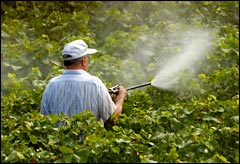In 1962, Rachel Carson published her landmark Silent Spring, which documented the ravages of agricultural pesticides, particularly DDT, on wildlife. The book inspired wide outrage and helped spark the modern environmental movement. It eventually led to a (now-controversial) ban on DDT. But since then, use of other pesticides has boomed.

Sign of the times?
Photos: iStockphoto
According to a USDA report, between 1964 and 1982, pesticide use in the U.S. jumped by a factor of almost three, peaking at nearly 600 million pounds annually. The USDA is shockingly casual about releasing current pesticide statistics. The freshest data I can find show pesticide use hovering at 500 million pounds in 2002 — more than double the 1964 level.
This annual avalanche of toxins onto our crops and soils has been accompanied by mounting evidence of their ill effects on public health — particularly that of farmers and farmworkers. The latest entry: a study from Canada showing that women who had worked on farms were nearly three times as likely as other women to develop breast cancer.
The Agricultural Health Study, a joint venture of several public-health agencies, has revealed direct links between chemical-intensive farming and both prostate cancer and retinal degeneration. A link has also been established between pesticide use and Parkinson’s disease.
Shifting the Burden
If Carson’s book had a limited effect on the rising tide of pesticide use, it probably did affect the types of agricultural poisons used.
In 1990’s The Death of Ramon Gonzales: A Modern Agricultural Dilemma, Angus Wright argued that Silent Spring sparked a backlash against so-called “persistent” pesticides, which build up over time in soil, groundwater, and the bodies of animals. These dangerous chemicals also tend to cling in residue form to fruits and vegetables in the supermarket.
The agrichemical industry’s response — embraced by farm owners, government regulators, and global aid institutions — was to promote pesticides that break down rapidly. But these alternatives, known as “non-persistent” chemicals, are much more dangerous at the time of application. The strategy, Wright says, was to placate public fear about pesticide poisoning by shifting as much of the risk as possible onto farm ecosystems and farmworkers, and away from consumers and the broader environment.
The shift occurred later in Mexico and other developing nations than in the U.S., Wright shows. That’s because the chemical industry’s first reaction to U.S. public anger about DDT and other “persistents” was to shut them out of the U.S. market and push them on farmers in the global south, which had weaker regulatory regimes. But muckraking journalists exposed a “circle of poison”: chemicals that had been banned in the United States were reappearing in U.S. supermarkets heavily stocked, particularly in winter, with Mexican fruit and vegetables.

Farm at your own risk.
As a result of public outcry, use of the quicker-to-break-down but highly toxic non-persistent chemicals then exploded in the global south, particularly in areas characterized by export-oriented farming. This early-1980s switch had “immediate and tragic consequences for farmworkers,” according to Wright. Despite strong industry-backed standards requiring that anyone handling such poisons be protected by respirators, rubber coveralls, and other gear, Wright observed such requirements being routinely violated by large, export-minded landowners.
Such violations remain routine — and not just in Mexico. A 2002 report [PDF] spearheaded by the Pesticide Action Network summarizes findings from California’s Department of Pesticide Regulation. The agency surveyed a sampling of pesticide-reliant farm operations between 1997 and 2001. Fully one-third violated regulations involving protective equipment, washing facilities, and fieldworker access to pesticide use information. The agency claimed that 88 percent of the protective-equipment violations stemmed from employer negligence.
In Death, Wright traces the fate of one young farmworker who died in 1981, most likely from exposure to a class of non-persistent insecticides known as organophosphates. Many products from this pesticide class — which came upon the world stage as a nerve gas developed by German engineers during World War II — remain legal in the United States. Two months ago, after contemplating the matter for 10 years, the U.S. EPA approved use of 32 organophosphates — a decision so egregious that it prompted a public outcry from hundreds of agency scientists who claimed their leaders had been swayed by industry influence.
Like the oil industry, agribusiness survives on its ability to privatize profits and socialize costs. Heavy pesticide use helped bring about short-term gains in crop yields, which has meant billions in profits for grain traders, food processors, agrichemical giants, and other food-related multinational corporations. To these firms, pesticide-related deaths and maladies are what economists call an “externality” — a cost that lands in someone else’s ledger.
That the burden has been engineered to fall most heavily on farmworkers — a group not known for its access to high-level health care — is particularly galling.
Farmworker health has quietly become a kind of human sacrifice at the altar of cheap food. Consumers in the U.S. benefit from — and low-income people rely on — the world’s cheapest food system. They owe it to farmworkers to demand an end to, or at least a severe reduction in, pesticide use. Consumer hell-raising helped ban DDT and other persistent pesticides in the 1970s. More than 40 years after the publication of Silent Spring, it’s time to finish the job.

